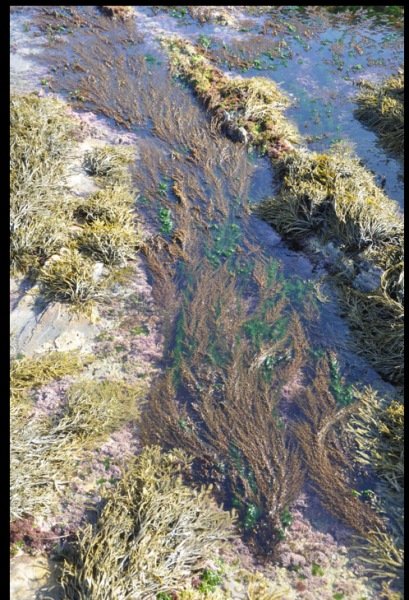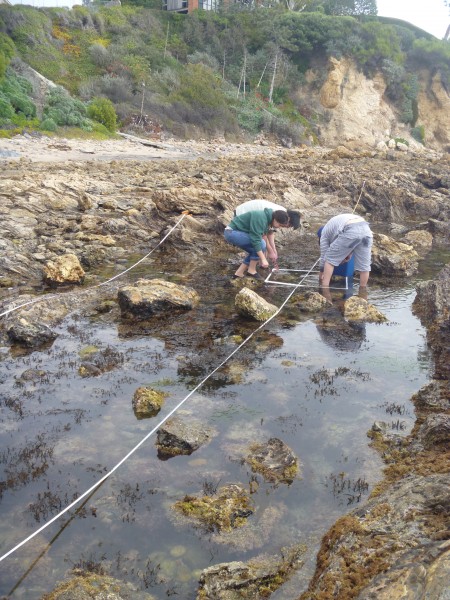Experts say it came over to North America from Japan 10 years ago, clinging to the hulls of freighters.

Sargassum horneri, the invasive seaweed, then jumped ship, recently landing in the rocky tidepools and deeper sub-tidal zones along the Southern California coast. Some experts say it’s sucking the daylight, and, hence, the life out of local tidepools. Its cousin, sargassum muticum, was swept over the oceans to our shores more than 40 years ago.
The latest invader, horneri, is out of control, said Jim Eckman of La Jolla’s Scripps Institute of Oceanography. “It’s changing the ocean,” he said. Some scientists say something needs to be done soon. And state wildlife officials generally agree, though budget constraints hinder their ability to battle the aquatic invader. An even greater hurdle results from restrictions on removing species from Marine Life Protected Areas, where the seaweed flourishes unchecked.
The fast-growing, golden brown seaweed that attaches to rocks by a holdfast dominates tidepools, Eckman said. Plants make oxygen when the sun’s up, but use it during the night. “If you have enough of these plants in a small volume of water and it’s dark, they will use up all the oxygen in the tidepool as well and they can basically kill things by hypoxy, by oxygen deprivation,” he said.
Horneri shuts out native species and depletes needed nutrients from the water, said Bill Bushing, PhD in ecology, evolution and marine ecology, who logs more than 300 scuba dives at Catalina Island a year. In an online video, he asked the state’s Department of Fish and Wildlife to remove the pervasive weed, which self-fertilizes. Fish don’t eat it, he said, because it produces a toxin to them.

The DFW agrees that invasives are unwelcome guests. “Obviously, we don’t want invasive species impacting the naturally occurring local resources,” said Bill Paznokas, a DFW environmental scientist in San Diego. But due to state budget cuts and the way the plant reproduces, ousting the intruder will not be included in the state’s Aquatic Invasive Species Management Plan anytime soon. The plan proposes actions against 312 aquatic invaders.
“Small pieces can break off the adult horneri plant and float away and it can re-establish that way,” said Paznokas. He said the plant’s fertilized offspring sink to the bottom of the ocean and quickly take root. “Those you don’t see at first.”
But control is possible, he said. In Japan, where sargassum is indigenous, it’s harvested as fertilizer. “That may be one means of control,” Paznokas commented. Ten pounds of seaweed can be removed a day with a valid California fishing license, but not in a marine reserve, which covers nearly all of Laguna Beach’s coastline.
The state’s plan for managing invasives, said Susan Ellis, the DFW’s manager of invasive species program, deals more with prevention than removal.
Some scientists think the sargassum horneri invasion might even be beneficial to the tidal ecosystem.
Jayson Smith, a biology professor at Cal-Poly Pomona, conducted a nine-month study in 2012 at Little Corona del Mar tidepools on the effects of sargassum muticum and detected no change in the ecosystem. “It doesn’t appear to have any effect,” Smith said. He stipulated, however, that there might be problems in deeper water that he hasn’t detected. He also noted other studies stating that sea animals avoid sargassum because there’s no food there.
Dan Pondella, an Occidental College biology professor, compares sargassum to the “killer algae” (culerpa taxifolia) unleashed from a public aquarium in Monaco and running havoc in the Mediterranean Sea. Pondella’s team studies algae and fauna in the rocky reefs and kelp beds of Laguna’s local Marine Life Protected Area, which extend as far as three miles out to sea.
Culerpa found its way to Carlsbad and Huntington Harbour 11 years ago, where it was extricated. “It wiped out everything and nothing would eat it,” Pondella said of the Mediterranean invasive. “Sargassum’s kind of similar to that, nothing eats it.” Pondella said he’s seen no evidence that the seaweed’s canopy protects species already there. “I can’t imagine an invasive species being positive.”
Scientists claim that sargassum forces diverse tidepool communities of sea anemones, mussels, barnacles, crabs, snails, fishes and smaller plants toward a less-diverse habitat. That, they note, threatens the vitality of tidepools already weakened by other threats, such as run-off pollutants.
So, sargassum might be here to stay.
Letty Skeen, a seven-year tidepool educator with Laguna Ocean Foundation, completes daily logs of activities, incidents and unusual occurrences, mostly at Treasure Island tidepools below the Montage resort. She’s seen a proliferation of sargassum, also known as wireweed, over the past two years as well as sea creatures munching it down to the nibs. “I’ve seen hermit crabs strip it,” she said, “and also sea hares. Last year, it was stripped. When they strip it, it looks like wire.”
This year, she said nothing’s eating it. Skeen hasn’t observed any other changes in the tidepools’ diversity and considers the sargassum canopy as possible protection for the animals from predators and the hot sun.
Human activity is the real culprit behind invasive species, Eckman said. “Humans have really facilitated the invasion of plants in the marine realm globally through shipping. By the time these dangers are noted, they’re typically extensively established and the effort involved in getting them out is formidable. It costs a lot of money, it takes a lot of manpower and the state doesn’t have the kind of resources that we would like to help manage that.”




